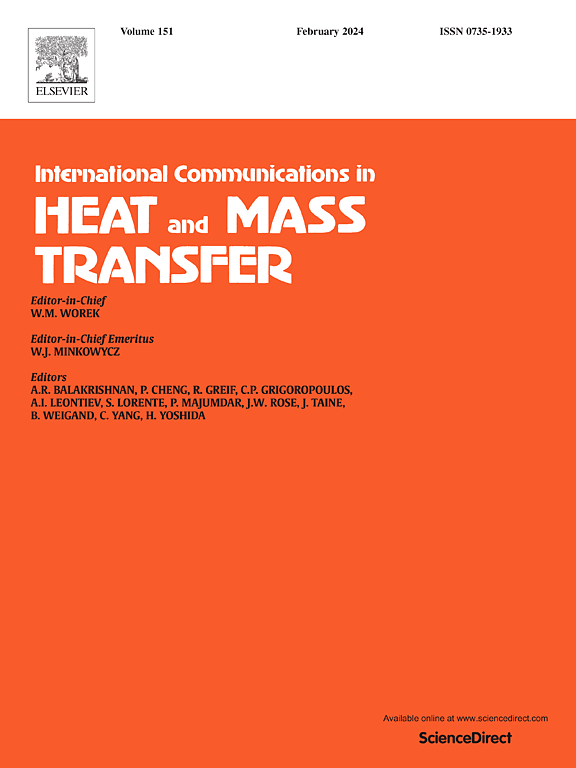A comprehensive review of solar energy systems: Technical, economic, and environmental perspectives for sustainable development
IF 6.4
2区 工程技术
Q1 MECHANICS
International Communications in Heat and Mass Transfer
Pub Date : 2025-05-19
DOI:10.1016/j.icheatmasstransfer.2025.109095
引用次数: 0
Abstract
The pressing need for sustainable energy solutions is highlighted by the depletion of non-renewable energy sources and its effects on the environment. One of the most plentiful renewable resources, solar energy is a viable substitute to slow down global warming and improve energy security. However, geographical factors and technology developments determine its effectiveness, economic feasibility, and environmental advantages. The technical performance, economic viability, and sustainability potential of solar energy systems—photovoltaic (PV), photovoltaic-thermal (PV/T), concentrated solar power (CSP), and hybrid systems—are all thoroughly examined in this paper. This analysis contrasts various systems, stressing important economic metrics like Levelized Cost of Energy (LCOE) and environmental advantages like carbon reduction, in contrast to earlier research that concentrated on a single technology. A thorough examination of the literature was done, evaluating solar systems according to their cost, efficiency, and ability to reduce emissions in different climates. According to the results, hybrid solar and CSP systems outperform fossil fuels in terms of efficiency. PV and PV/T systems have the lowest LCOEs in terms of economics, at $0.11/kWh and $0.02/kWh, respectively. While CSP varied between $0.1219/kWh and $0.1722/kWh, hybrid systems ranged from $0.0589/kWh to $0.585/kWh. Emissions are reduced by 9.1 t CO₂/kWh with PV systems and 3.92 t CO₂/kWh with CSP. The necessity of optimizing solar technology to increase efficiency and lower prices is highlighted by this study. Solar energy has the potential to significantly contribute to the worldwide shift to sustainable energy by overcoming technological and financial obstacles.
全面审查太阳能系统:可持续发展的技术、经济和环境观点
不可再生能源的枯竭及其对环境的影响突出了对可持续能源解决办法的迫切需要。太阳能是最丰富的可再生资源之一,是减缓全球变暖和提高能源安全的可行替代品。然而,地理因素和技术发展决定了它的有效性、经济可行性和环境优势。本文对太阳能系统的技术性能、经济可行性和可持续性潜力——光伏(PV)、光伏-热(PV/T)、聚光太阳能(CSP)和混合系统——进行了全面的研究。该分析对比了不同的系统,强调了重要的经济指标,如平准化能源成本(LCOE)和环境优势,如碳减排,而不是早期的研究集中在单一技术上。对文献进行了彻底的检查,根据太阳能系统的成本、效率和在不同气候下减少排放的能力对其进行了评估。根据结果,混合太阳能和CSP系统在效率方面优于化石燃料。PV和PV/T系统在经济性方面的lcoe最低,分别为0.11美元/千瓦时和0.02美元/千瓦时。CSP的价格在0.1219美元/千瓦时至0.1722美元/千瓦时之间,混合动力系统的价格在0.0589美元/千瓦时至0.585美元/千瓦时之间。使用PV系统可减少9.1吨二氧化碳/千瓦时的排放量,使用CSP系统可减少3.92吨二氧化碳/千瓦时的排放量。该研究强调了优化太阳能技术以提高效率和降低价格的必要性。通过克服技术和财政障碍,太阳能有可能对全世界转向可持续能源作出重大贡献。
本文章由计算机程序翻译,如有差异,请以英文原文为准。
求助全文
约1分钟内获得全文
求助全文
来源期刊
CiteScore
11.00
自引率
10.00%
发文量
648
审稿时长
32 days
期刊介绍:
International Communications in Heat and Mass Transfer serves as a world forum for the rapid dissemination of new ideas, new measurement techniques, preliminary findings of ongoing investigations, discussions, and criticisms in the field of heat and mass transfer. Two types of manuscript will be considered for publication: communications (short reports of new work or discussions of work which has already been published) and summaries (abstracts of reports, theses or manuscripts which are too long for publication in full). Together with its companion publication, International Journal of Heat and Mass Transfer, with which it shares the same Board of Editors, this journal is read by research workers and engineers throughout the world.

 求助内容:
求助内容: 应助结果提醒方式:
应助结果提醒方式:


